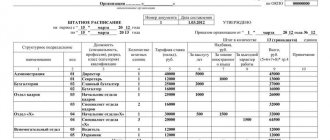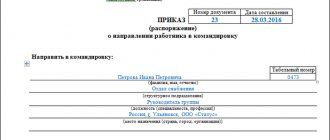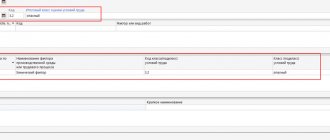By virtue of the law, each company maintains a number of mandatory and auxiliary documents at the local level, which allow not only the efficient use of labor resources, but also analyze their inflow or outflow.
Dear readers! The article talks about typical ways to resolve legal issues, but each case is individual. If you want to find out how to solve your particular problem , contact a consultant:
+7 (499) 110-43-85 (Moscow)
+7 (812) 317-60-09 (Saint Petersburg)
8 (800) 222-69-48 (Regions)
APPLICATIONS AND CALLS ARE ACCEPTED 24/7 and 7 days a week.
It's fast and FREE !
One of these documents is the staffing arrangement, which makes it possible to track many nuances of personnel processes in a single form.
Content
- Number of staff: what is it?
- Interpretation of the term
- Established and actual strength: differences
- Why do you need staffing and structure?
- Methodology for determining staffing levels
- Standards
- How to calculate staff size
- Certificate of staffing levels
- Conclusion
All entrepreneurs at some point begin to increase the staff of their company. As your business grows and expands, the number of employees increases. And the larger it is, the more difficult it is to determine the actual number of employees. Today we will find out what this indicator is and how it is calculated.
Number of staff: what is it?
There are several types of numbers and each of them is reflected differently in reporting.
Let's give a brief description of each type:
- Safe house . Reflects the number of employees at the place of work;
- Regulatory . It is regulated by labor standards and the amount of work that needs to be performed;
- Average pay . Represents the average value of the number of employees who performed their duties in a specific period of time. This list does not include external part-time workers and those who work under civil contracts;
- Actual . Represents the number of all working employees on a specific date;
- Regular . Takes into account only those employees whose rates are fixed in the staffing table, excluding seasonal ones;
- Planned . The number is influenced by labor productivity, company specifics and other factors.
Next, we will dwell in more detail on the staffing and actual number of employees.
Who is not on the list?
View gallery
There are not always employees on the payroll at enterprises. This applies to those categories of citizens who cannot be included in the list:
- not included in the state;
- those employed part-time;
- working under an agreement with a government organization;
- temporarily employed;
- teachers who have been given a break from work;
- school students;
- Young professionals;
- fired employees.
There are other employees on the payroll at the enterprise. External part-time employees are employees who perform their duties at 2, 1.5 or less than 1 rate. In this case, the employee is counted as one employee. The list of employees for the month should include those specialists hired on a specific date. It should not include laid-off employees.
Interpretation of the term
The concept of staffing levels is not contained in labor legislation. It is determined independently by employers. Before talking about calculations, it is worth understanding the general definition.
The staffing level of an organization is the number of employees needed to fulfill the company's production plans. This indicator is reflected in the staffing table, which is formed based on this indicator. Also, based on the staffing level, the wage fund is planned.
Regulatory acts on determining the number
In this area, there are norms of legislation (mainly tax), as well as orders and instructions on the rules for determining the payroll and average number of employees for submitting these reports to statistical authorities.
The orders also determine who must submit these reports and within what time frame.
The headcount standard is the number of employees who have certain professional qualifications to perform certain managerial or production functions or in given organizational and technical conditions.
To calculate these standards, the composition or volume of work that is most typical for a given category of personnel is taken into account. Therefore, the indicator is not very accurate: with any deviation of the actual indicators from the standard indicators, the accuracy of the result decreases. Most often, standards are presented in the form of calculated dependencies or normative tables compiled on their basis.
In a broad sense, the number of employees is the number of employees of a company or enterprise included in its staff. Or this is the number that appears in the staffing table approved by the manager (this is a mandatory requirement).
It is also worth noting that seasonal workers or employees with whom you enter into temporary employment contracts are not included in the general staffing table. Therefore, they do not need to be taken into account.
We invite you to read: Guardian and trustee: what is the difference and are there any differences?
The use of this concept has become especially widespread in business planning when determining the number of personnel. It is also quite often found when discussing the most effective solutions to management issues related to the development of an enterprise or company.
Since it is not easy to calculate the number of employees, it is necessary to take into account the standards for recording working hours. This will greatly facilitate the work of HR specialists. This indicator records the total working time costs that the head of an enterprise or the corresponding department sets for a specific employee or group of employees.
It is important to remember that the employees themselves must strictly correspond to the level of qualifications necessary to perform a certain task. Otherwise, the standards for recording labor time will have to be adjusted. Moreover, if employees are less qualified than required, then to a greater extent, which will lead to the fact that the final goal will be achieved much later than planned.
All work at the enterprise must be covered by these temporary standards. Only in this case will production function smoothly and smoothly. In addition, thanks to labor time tracking, you will receive objective data on the required number of personnel. At this stage, it is possible to revise the number of employees in the direction of increasing or decreasing the number of employees.
Calculation of temporary standards is also considered mandatory for the HR department. They are also classified as time costs. These include researching the provisions of regulatory documents, preparing and sending relevant requests, studying and analyzing materials and data related to the specific industry in which your company operates. It is also important to monitor the implementation of planned programs and plans.
Also, the time standards include those costs that are necessary for the implementation of activities, without which the implementation of the assigned tasks will be impossible, as well as the hours that will be spent on preparing the final financial statements.
These standards are determined based on the established staffing levels. The corresponding figures are included in the report card.
These indicators, as a rule, are established in all companies for one financial year. At the same time, the number of employees must comply with the standards, the total labor costs that are necessary to complete a specific task.
When determining the final staffing level, it is important to take into account and correctly calculate the absenteeism rate. It is necessary to include the time that employees spend on planned vacations, days that on average will be devoted to advanced training, training and retraining, and take into account temporary disability.
Don't forget about correction factors. These include the time that an employee spends on personal needs or rest during work. For example, these include smoking breaks. We must not forget about them, because otherwise the output numbers will be incorrect and you will not get the result you expected.
Established and actual strength: differences
Based on the definition of staffing levels, the difference is as follows: the staffing level includes all positions, including vacant ones, while the actual number includes only those occupied by employees.
The actual number is determined based on the working time sheet maintained by the company or enterprise. At the same time, they take into account what date each employee went to work.
There are situations when the actual number exceeds the staffing level. The reason for this is the involvement of temporary workers who only periodically perform any work.
If an entrepreneur works under the simplified tax system or a patent, the staffing level cannot be exceeded.
Where is it necessary to compile a payroll?
This is necessary for all businesses that have their own balance sheet. The payroll number refers to legal entities. All information about the units and brigades within the organization is entered into this documentation.
View gallery
It should be borne in mind that even if the department is not part of the company, but belongs to it, it must be included in the report. The exception includes divisions with their own balance sheet. In this case, you can transfer the necessary information to the central office or statistical authorities.
The report preparation procedure is divided into time frames. They must be completed monthly, quarterly or annually. You must always follow the rule: the period begins on the 1st day of the period and ends on the last day. For example, a report can be generated from January 1 to December 31, even if these are holidays. You must submit the documentation on time, otherwise you will have to pay a fine.
Why do you need staffing and structure?
The staffing table is a document that reflects the structure of the company and the number of employees in it. Scheduling is not a mandatory procedure for companies. The law does not require this.
The number of staff and the structure of the company are prescribed in the statutory documents. This is especially important when the organization is developing dynamically.
You should not refuse to draw up these documents; this allows you to avoid too much burden on the company, both new and existing. In addition, the schedule contains a list of all divisions of the organization with a management hierarchy.
The need for staffing is also clear. It reflects not only how many people work in the company, but also their official salaries.
The schedule is approved by order of the organization.
What it is?
Among HR managers, the document is better known as personnel replacement. This is a list of existing positions in the company with an indication of the persons replacing them.
Such a local regulatory act conveys the overall personnel picture of the enterprise and is used for the convenience of the employer and HR.
Example of personnel replacement
What is the convenience:
- existing vacancies are clearly reflected;
- the distribution of employees across departments is visible, which simplifies the possible optimization of the number;
- allows you to process a large amount of data in organizations with a large number of employees.
The most important thing is that the absence of a mandatory form allows you to reflect the necessary data in the document, providing additional columns.
Methodology for determining staffing levels
Rosarkhiv offers its own methodology, on the basis of which the staffing level can be determined. It lies in the fact that when making calculations you need to rely on standards that relate to labor relations.
According to Rosarkhiv, the number of staff should be established separately for each structural division of the company. This technique allows you to find out what the optimal number of employees is for any organization.
There are also advisory legislative acts that explain how staffing levels are calculated. In particular, we are talking about recommendations for determining staffing levels in budgetary institutions, but the calculations given in this document can be used by any companies and organizations.
Information in the personnel arrangement
This code is one of the most voluminous and detailed personnel documents. There is no mandatory list of data, but years of office work practice have formed an ideal list of necessary information:
- name of the enterprise division (name of department, workshop, branch, representative office);
- department code (if an enterprise has a large number of departments, they may be codified, but this item is not mandatory);
- positions and their number provided for in individual structural units;
Sample personnel arrangement in an organization
- wages broken down into three components - salary, allowances, total amount;
- surname, name, patronymic of employees;
- details of orders on personnel movements;
- additional information at the request of the employer (vacation, maternity leave, temporary disability, suspension from work, and so on).
This information largely duplicates the personnel schedule, which is natural, since the latter is the basis for staffing.
https://youtu.be/k04Jf3rVQdY
Standards
To calculate the optimal staff size, you need to use the following types of standards:
- Working time standards;
- Production standards;
- Controllability standards;
- Maintenance standards.
Let’s talk further about what is meant by these indicators.
Working time standards.
This is the amount of working time required for employees to perform a specific job.
Production standards.
This is a fixed amount of work that must be completed by one person or group within working hours.
Controllability standards.
This is the number of employees whose activities can be coordinated by one manager.
Maintenance standards.
These are jobs or clients that a specialist must serve during his working hours.
Next, let's talk about the procedure for calculating the number.
Report requirements
The document is drawn up in the prescribed form. There are many types, but there is one suitable for every occasion. Only then will it be possible to accurately determine the number of employees. This is necessary for proper document management. In this case, all notes are made based on the originals. For example, if an employee is sick, then it is prohibited to make changes without a sick leave.
Another important point is the transfer of departments or employees between companies. In this case, you can delete a person from the document only in the next period. Data entry is also carried out. If an error is noticed, changes must be made to the report in which the problem appeared.
View gallery
The average headcount is used to identify labor productivity, average wages, and turnover. A calculation for a specific period is required. To determine the average headcount, it is necessary to divide the number of employees by the number of days in a month (including workdays and holidays).
How to calculate staff size
To perform calculations correctly, you need to decide how many employees are required in order for the enterprise to work productively.
So, you need to take into account:
- What volume of work is planned to be completed in a specific period of time;
- What output does one employee make per hour, and so on.
In addition, you need to take into account that all employees take vacations, time off, and go on sick leave. Therefore, it is also necessary to determine the rate of absenteeism of people from work. It is expressed in hours, and is calculated using the following formula: 1 *% of people who did not go to work (of the total number of employees) / 100 .
When we determine the standard number, we apply a different formula: operating time * planned output * planned revenue * coefficient of fulfillment of the planned norm / planned volume of work .
It turns out that the optimal number of staff will be equal to: standard number * employee absenteeism rate .
Certificate of staffing levels
Why is this document needed?
In fact, there may be several reasons:
- Required by the tax office . This reason is the most common. Based on the information from this certificate, inspectors find out which company must provide reports in paper form and which can report electronically;
- Request from a banking organization . Nowadays it also often occurs, especially if a company has applied for a lending service;
- Pension Fund request.
How to compose?
On the approved form, please indicate the following information:
- Name of the certificate;
- Full name of the Federal Tax Service;
- The name of the legal entity or entity that makes the calculation;
- TIN certificate;
- checkpoint;
- The number of employees according to the staffing table for a specific date;
- Date when the form was filled out;
- Signature and transcript of the signature of the responsible person.
It is better to fill out two copies - keep one for yourself, and send the second to the place of requirement.
Briefly about the Bank Cabinet
Due to the large number of financial organizations and registration methods, it can be difficult for users to understand the intricacies of creating a personal account.
All Internet banking in Russia
To help bank clients, the following information is posted on the Bank Account website:
- briefly about the bank, link to the official website and contact information;
- detailed instructions for creating your account for individuals and legal entities;
- description of opportunities and latest offers from financial institutions;
- requirements for users wishing to create their profile or apply for a loan.
If a site visitor cannot find an answer to his question, he can contact a lawyer by writing a message to him in the lower window on the right. The user also has the opportunity to order a call from a specialist who can call back at a convenient time.









